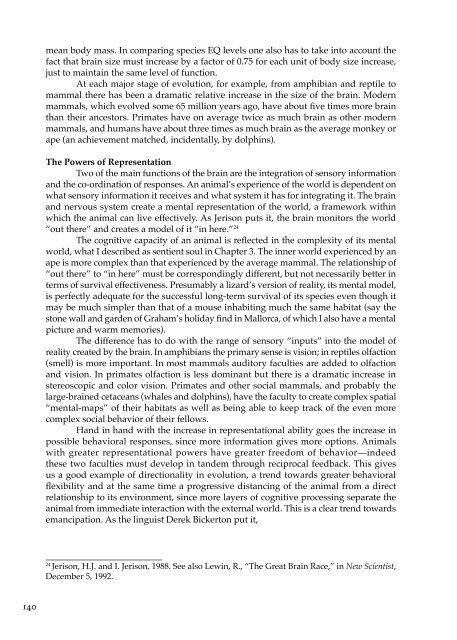The Spirit in Human Evolution - Waldorf Research Institute
The Spirit in Human Evolution - Waldorf Research Institute
The Spirit in Human Evolution - Waldorf Research Institute
Create successful ePaper yourself
Turn your PDF publications into a flip-book with our unique Google optimized e-Paper software.
mean body mass. In compar<strong>in</strong>g species EQ levels one also has to take <strong>in</strong>to account the<br />
fact that bra<strong>in</strong> size must <strong>in</strong>crease by a factor of 0.75 for each unit of body size <strong>in</strong>crease,<br />
just to ma<strong>in</strong>ta<strong>in</strong> the same level of function.<br />
At each major stage of evolution, for example, from amphibian and reptile to<br />
mammal there has been a dramatic relative <strong>in</strong>crease <strong>in</strong> the size of the bra<strong>in</strong>. Modern<br />
mammals, which evolved some 65 million years ago, have about five times more bra<strong>in</strong><br />
than their ancestors. Primates have on average twice as much bra<strong>in</strong> as other modern<br />
mammals, and humans have about three times as much bra<strong>in</strong> as the average monkey or<br />
ape (an achievement matched, <strong>in</strong>cidentally, by dolph<strong>in</strong>s).<br />
<strong>The</strong> Powers of Representation<br />
Two of the ma<strong>in</strong> functions of the bra<strong>in</strong> are the <strong>in</strong>tegration of sensory <strong>in</strong>formation<br />
and the co-ord<strong>in</strong>ation of responses. An animal’s experience of the world is dependent on<br />
what sensory <strong>in</strong>formation it receives and what system it has for <strong>in</strong>tegrat<strong>in</strong>g it. <strong>The</strong> bra<strong>in</strong><br />
and nervous system create a mental representation of the world, a framework with<strong>in</strong><br />
which the animal can live effectively. As Jerison puts it, the bra<strong>in</strong> monitors the world<br />
“out there” and creates a model of it “<strong>in</strong> here.” 24<br />
<strong>The</strong> cognitive capacity of an animal is reflected <strong>in</strong> the complexity of its mental<br />
world, what I described as sentient soul <strong>in</strong> Chapter 3. <strong>The</strong> <strong>in</strong>ner world experienced by an<br />
ape is more complex than that experienced by the average mammal. <strong>The</strong> relationship of<br />
“out there” to “<strong>in</strong> here” must be correspond<strong>in</strong>gly different, but not necessarily better <strong>in</strong><br />
terms of survival effectiveness. Presumably a lizard’s version of reality, its mental model,<br />
is perfectly adequate for the successful long-term survival of its species even though it<br />
may be much simpler than that of a mouse <strong>in</strong>habit<strong>in</strong>g much the same habitat (say the<br />
stone wall and garden of Graham’s holiday f<strong>in</strong>d <strong>in</strong> Mallorca, of which I also have a mental<br />
picture and warm memories).<br />
<strong>The</strong> difference has to do with the range of sensory “<strong>in</strong>puts” <strong>in</strong>to the model of<br />
reality created by the bra<strong>in</strong>. In amphibians the primary sense is vision; <strong>in</strong> reptiles olfaction<br />
(smell) is more important. In most mammals auditory faculties are added to olfaction<br />
and vision. In primates olfaction is less dom<strong>in</strong>ant but there is a dramatic <strong>in</strong>crease <strong>in</strong><br />
stereoscopic and color vision. Primates and other social mammals, and probably the<br />
large-bra<strong>in</strong>ed cetaceans (whales and dolph<strong>in</strong>s), have the faculty to create complex spatial<br />
“mental-maps” of their habitats as well as be<strong>in</strong>g able to keep track of the even more<br />
complex social behavior of their fellows.<br />
Hand <strong>in</strong> hand with the <strong>in</strong>crease <strong>in</strong> representational ability goes the <strong>in</strong>crease <strong>in</strong><br />
possible behavioral responses, s<strong>in</strong>ce more <strong>in</strong>formation gives more options. Animals<br />
with greater representational powers have greater freedom of behavior—<strong>in</strong>deed<br />
these two faculties must develop <strong>in</strong> tandem through reciprocal feedback. This gives<br />
us a good example of directionality <strong>in</strong> evolution, a trend towards greater behavioral<br />
flexibility and at the same time a progressive distanc<strong>in</strong>g of the animal from a direct<br />
relationship to its environment, s<strong>in</strong>ce more layers of cognitive process<strong>in</strong>g separate the<br />
animal from immediate <strong>in</strong>teraction with the external world. This is a clear trend towards<br />
emancipation. As the l<strong>in</strong>guist Derek Bickerton put it,<br />
_________________________<br />
24<br />
Jerison, H.J. and I. Jerison, 1988. See also Lew<strong>in</strong>, R., “<strong>The</strong> Great Bra<strong>in</strong> Race,” <strong>in</strong> New Scientist,<br />
December 5, 1992.<br />
140
















